Do You Have To Remove Wallpaper Glue Before Painting
How to Remove Wallpaper
It'southward an ugly job. We tin can't make it pretty, only we can arrive easier. Learn how to remove wallpaper
![]() Time
Time
Multiple Days
![]() Complexity
Complexity
Beginner
![]() Price
Price
$51–100
Introduction
Removing wallpaper before painting is a tough job, but it doesn't have to be terrible. Larn how to make information technology get quicker and easier and how to make sure you end upward with walls that are smooth and clean.
Tools Required
Materials Required
- Drywall sanding paper
- Gel stripper
- Joint compound
- Painter's tape
- Plastic drop cloth
- Scoring tool
Mental Preparation
Nosotros're non going to sugarcoat it. Wallpaper removal is a messy, time-consuming and boring task. We wish at that place was a swell new production that will make old wallpaper removal easy. But there isn't an easy style to remove wallpaper mucilage. And if you don't know what you're doing or you lot start to get frustrated, you tin can harm your walls, or stop before the job is done. Here's how to stock-still damaged walls.
The tips in this article won't make the chore fun. Simply they will help you do it more than efficiently, without damaging your walls. They'll besides show you how to get a wall perfectly clean, ready for a fresh glaze of paint or new wallpaper. Removable wallpaper is on-tendency in habitation decor correct now.
Do yourself a favor and accept a full weekend to practice the chore right. Attack the messy and difficult stuff on Day One and use the second 24-hour interval to prep the walls for paint or new wallpaper.
Learn how to paint like a pro and option upward some bang-up tips for achieving a perfectly smooth and even paint job.
Project step-past-pace (six)
Step 1
Protect the Flooring and Woodwork
- Everything is going to get moisture and sticky during this projection, so advisedly protect the flooring, furniture and woodwork.
- Take everything off the walls, including vents, outlet covers and switch plates, and mask the openings with plastic and tape.
- Plough off the electricity to the room at the service panel and use high-quality work lamps on extension cords to light your work surface area.
- If possible, remove the furniture completely.
- If non, move it to the center of the room and cover information technology with plastic.
- Tape plastic to the baseboard, allowing information technology to overlap the flooring about two feet.
- Pro tip: You'll want to protect the floors and prevent the water from running behind molding, baseboards and chair track.
- Do this by creating a plastic "gutter" to catch it.
- Elevation the plastic gutter with more plastic and so comprehend that with towels.
- Press hard on the tape to create a watertight seal.
- Cover the draped plastic with more than plastic and height that with towels to absorb the h2o as it runs downwardly the walls.
- Pro tip: Replace them with dry towels as necessary.
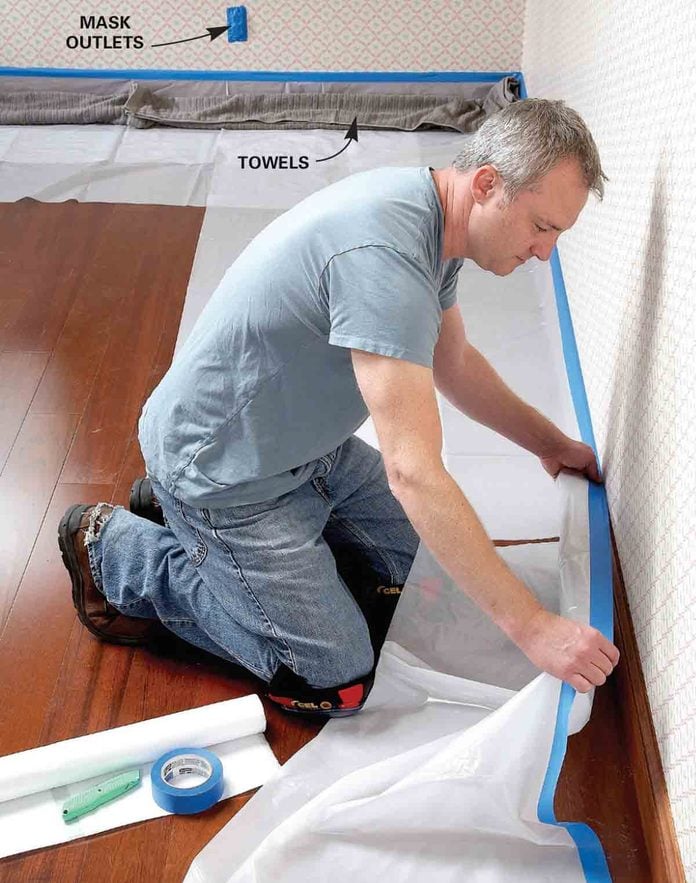
Step 2
Pull Off the Facing
- Do this stride without using any water to begin the old wallpaper removal process.
- Pro tip: The betoken is to remove the top layer of paper and get out the backing on the wall.
- That way, the backing will hands soak upward water, making the residual of the wallpaper removal faster and easier.
- Start at a corner near the ceiling or under a switch plate to begin. This is where the paper tends to exist loose.
- Use a putty knife to get the edge of the paper started, if necessary, and pull the paper back slowly at a 45-degree bending, applying moderate pressure.
- Yous can sometimes pull down entire sheets of newer wallpapers with this technique.
- But the longer the paper has been up, the more likely information technology is to come up off in smaller pieces (or non at all) as you endeavor to pare off wallpaper.
- If you just can't remove the facing at all, use a scoring tool before moving on to the next pace (come across "Tough Tools for Tough Situations," beneath).
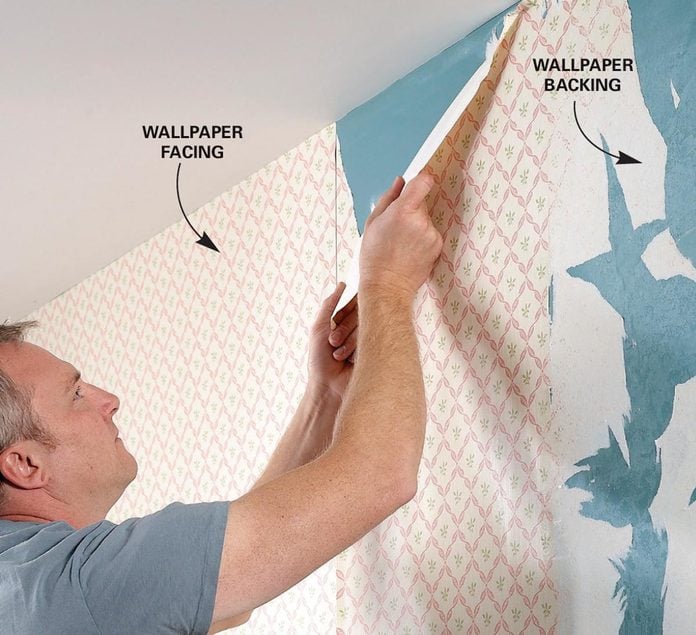
Stride 3
Soak Bankroll to Soften the Paste
- Apply the hottest water you can tolerate (vesture gloves!) to the wallpaper backing and the remaining facing to soften them and the agglutinative underneath.
- The hard part is doing this without damaging the wall surface.
- Plaster walls can take a lot of hot water without a problem.
- Simply drywall has a paper surface that tin can exist damaged by prolonged contact with water.
- Pro tip: Information technology'due south OK to moisten drywall, merely don't keep information technology wet for longer than 15 minutes at a time.
- Work in small-scale sections so the backing doesn't dry out before you lot have a chance for wallpaper removal.
- Apply the water using a sponge (or a floor mop for the high spots).
- Pro tip: This lets y'all control the corporeality of water you're applying each time.
- Let the backing absorb the water for up to fifteen minutes, until information technology starts to pull abroad from the wall.
- You may have to apply water several times to soften the paste.
- When the backing softens (utilize your fingernail or a scraper to check), you're gear up for the next step.
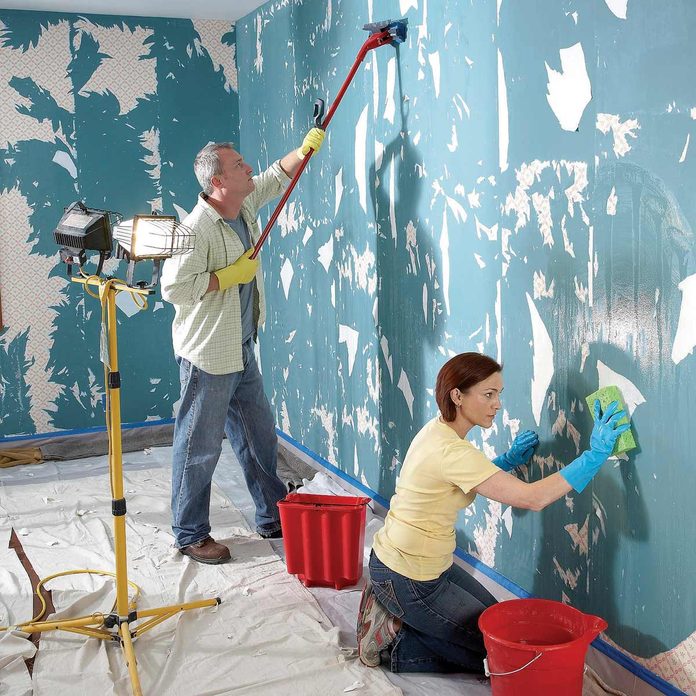
Step iv
Scrape Off the Backing
- Utilize an old, really flexible metal spatula or putty knife with rounded corners to scrape the backing and remaining facing off the wall.
- Using a flexible bract is key considering it won't dig into the drywall as much.
- Plastic spatulas or scrapers don't piece of work — they're likewise thick to get underneath the backing.
- If you don't have a rounded putty pocketknife, file the corners.
- Don't be as well aggressive with the scraper. The drywall might be soft in spots and scraping besides hard tin easily gouge information technology.
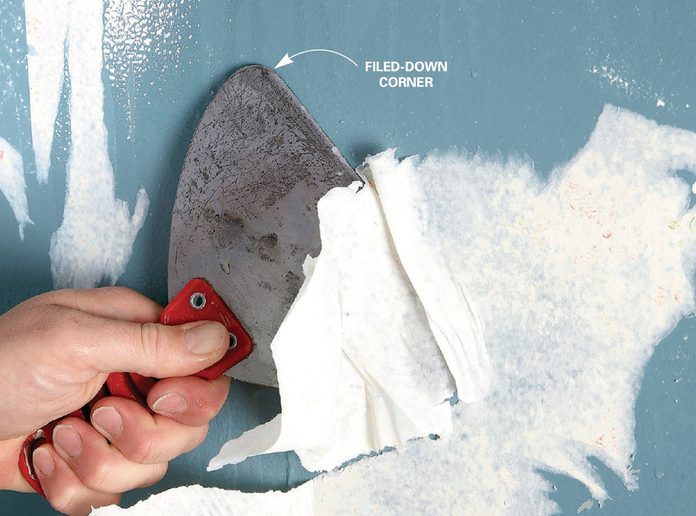
Step 5
Use Gel Stripper on Stubborn Paste
- This is the most of import footstep, simply the one that typically gets short shrift.
- There'southward going to be a lot of paste on the wall once the backing is gone, and it's going to take a lot of effort to get it all off.
- Scrape off as much of the glue with a putty knife as you tin can.
- And then launder the walls thoroughly with a sponge and water.
- Paste has a nighttime sheen to it and the wall will notwithstanding experience sticky.
- Pro tip: This is the moment when most people drop the brawl. You're tired, the wall looks clean and you but want to be done. And then the temptation is to call it a (very long) nighttime and "not come across" the paste that'due south nevertheless there.
- Spray a light mist of water on the "clean" wall.
- Hold your work low-cal parallel to the wall and you'll see the paste that remains.
- If y'all don't go information technology all off, when you paint the wall, the pigment volition eventually bit and crepitation. Wallpaper that's applied over information technology will chimera or fail to stick properly.
- Apply a gel stripper to get the last bits of stubborn paste and backing off the wall.
- Pro tip: Y'all won't need a whole lot, then it'due south non going to pause the depository financial institution.
- Spray any remaining paste and backing with gel stripper and let information technology sit down for 15 to 20 minutes.
- Since the gel clings to the wall, yous can scrape off the gel and the paste at the same fourth dimension with minimal cleanup.
- Subsequently the paste is completely gone, rinse the wall with water until it's smooth and squeaky clean.
- Pro tip: Now go to bed.
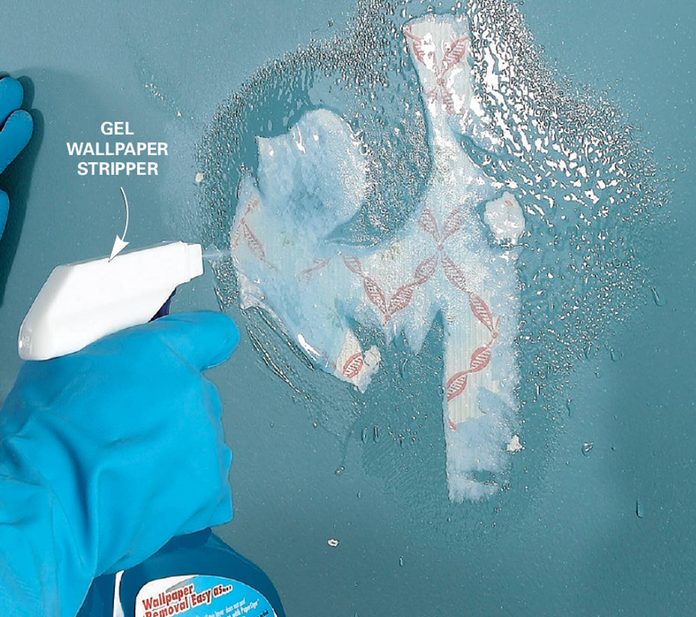
Step 6
Repair, Sand and Prime the Walls Smooth
- The next day after the wall has dried thoroughly, prep the wall for pigment or new wallpaper.
- Patch large gouges or holes from the scoring tools with joint chemical compound.
- If you have really banged-upward walls over a big area, trowel on a 1/16-in.-thick skim coat of joint compound over the entire wall.
- Once your repairs are dry, sand the wall until it's polish.
- Sand the wall using a hand sander and 120-grit drywall sanding newspaper to smoothen rough areas and remove any remaining backing or paste.
- If you lot plan to put upwardly new wallpaper, employ an acrylic primer that'southward formulated for wallpaper applications to make removing it easier the next time effectually.
- If you lot're going to paint, use a primer designed for that purpose.
- Pro tip: E'er prime a wall, fifty-fifty if it'due south painted, before putting wallpaper on it. If you don't, you might remove the newspaper surface of the drywall when you effort to remove it.
Read more well-nigh wallpaper and how to hang pre-pasted wallpaper should you want to wallpaper again.
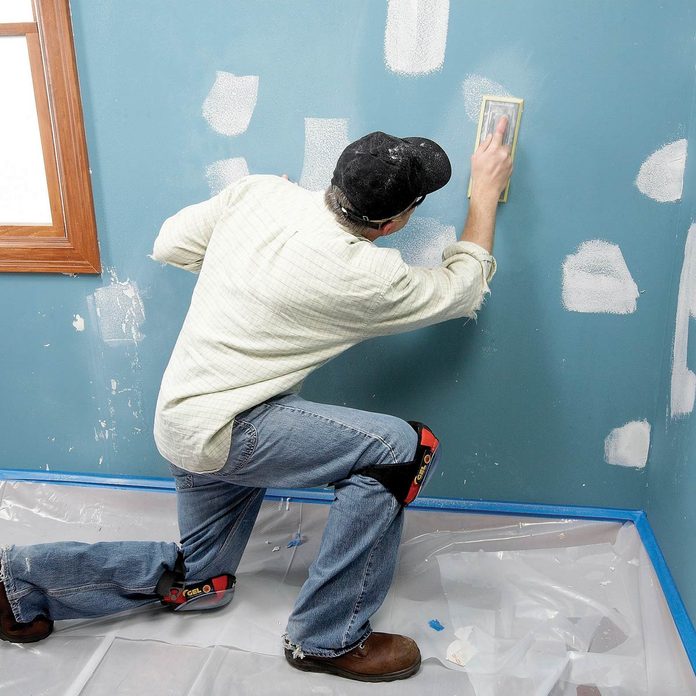
Originally Published: June eighteen, 2022
Do You Have To Remove Wallpaper Glue Before Painting,
Source: https://www.familyhandyman.com/project/the-best-way-to-remove-wallpaper/
Posted by: martinplefor.blogspot.com


0 Response to "Do You Have To Remove Wallpaper Glue Before Painting"
Post a Comment